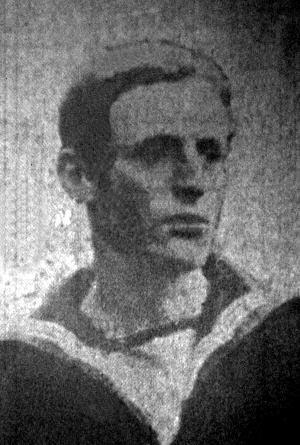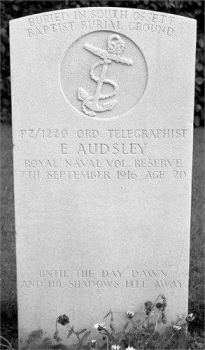

Edgar Audsley was born in Ossett on the 10th August 1896, the first child of Henry Robert Audsley and his wife Lillian (nee Harrop) who married in 1892. In 1901, Edgar was staying with his parents at his widowed grandfather’s home on The Green, Ossett, next door to a Harrop family. Both Edgar’s father and grandfather were cabinet makers originally from Horbury.
By 1911, Henry Robert and Lillian Audsley have two more children, Cecil (1903)and Victoria Mary (1906) when the family were living at 53, The Green, Ossett.
Edgar Audsley enlisted in the Royal Naval Volunteer Reserve and was posted to the W.T. Station Scarborough, Official Port Division Palace, where he died of disease on the 7th September 1916, aged 20.
The “Ossett Observer” 1 had this short obituary for Edgar Audsley:
“Wireless Operator Edgar Audsley (20), son of Mr. and Mrs. H.R. Audsley, of the Green, Ossett, whose death from inflammation of the kidneys, at Scarborough, where he was stationed took place last week-end, as previously announced, was interred at the Baptist Burial Ground, South Ossett, on Monday. Deceased was formerly the cinematograph operator at the Palladium and subsequently officiated in a similar capacity at Sutton, Surrey.”
Ordinary Seaman Telegraphist Edgar Audsley was buried at the First Baptist Church Burial Ground, Baptist Lane, Spa Street, Ossett, but due to the destruction of the Baptist Burial Ground in 2001, in part for residential housing, he is now remembered on a ‘Special Memorial’ the Stonefall Cemetery, Harrogate 2 that was erected in 1985 when the Baptist burial ground at Ossett was falling into disrepair.
It would appear that Edgar Audsley is only one of many men who have been “alternatively commemorated” by the Commission; an act which has effectively abandoned their mortal remains to eventual desecration at the hands of unscrupulous land developers. This policy would not be tolerated in France or Belgium, where the body would undoubtedly have been exhumed & reburied elsewhere. However, there appear to be legal complications for many Commission graves in the UK.
Despite the fact that a Commission headstone may be erected on a grave, the burial plot may be privately owned. Without the necessary legal authority or power, it seems that the CWGC are unable to act with the appropriate prerogative in such cases. The Commission only exhumed bodies in extreme cases; we assume mainly because of the complex legal issues involved in such an operation; but this statement does indicate that the Commission have some measure of responsibility for remains. According to the local newspaper, the builders are claiming a mix up over land boundaries.
In the local newspaper, Mr. Chris Hawley, minister at South Ossett Baptist Church said, “We had some complaints from health and safety officials saying some of the gravestones were unsafe. Our top priority is the safety of the public so we mounted a clean-up operation in the cemetery.
The cemetery itself has not been used for 30 years and no-one even visits it. We intend to put the graves back in a way they would be safer to the public and are asking for their patience with us while we do that. The last thing we want to do was upset people but we had to make the cemetery safe. There is no easy way to do this and I hope people can just keep their patience while we finish the job.”
Mr. Hawley’s words proved to be untrue and the burial ground has been destroyed by a JCB bulldozing the memorial markers on the graves, breaking them into fragments among piles of rubble. Stones commemorating soldiers killed fighting for the freedom of this country have been desecrated by the irreverent act of the Baptist Church.
A second Ossett soldier, who died just after the end of WW1, Jim Fox Elliott, of the Royal Field Artillery, was remembered on the now destroyed gravestone of his father Mr. George Elliott of Teal Street, Ossett at the same Ossett Baptist Burial Ground. Gunner Elliott died in hospital at Cherbourg, France from pneumonia on December 18th 1918, aged 24 years, and was laid to rest at Tourlaville Cemetery.
References:
1. “Ossett Observer”, 16th September 1916